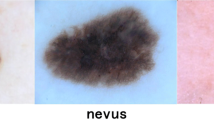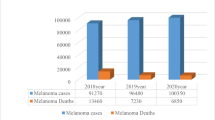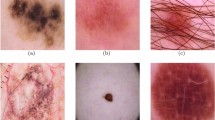Abstract
Due to variation in the appearance of the skin lesions, the noisy background, the small training dataset, and label imbalance, it is still a challenging task for melanoma recognition in dermoscopy images. Existing deep convolution network-based approaches usually adopted the global context captured in the fully connection layers (FC) to recognize melanoma, ignoring the local contexts which are beneficial for melanoma recognition. We adopted the DenseNet without FC to keep the maximum multi-scale skin lesion features flowing between layers. An attention module is designed to focus on the local contexts of the skin lesion captured in the intermediate Dense Blocks (InterDBs). After aggregating the local contexts and the global context captured in the last Dense Block (LastDB), the performance of melanoma recognition is improved. We proposed a novel feature confusion regularization, which reduces the Euclidean distance (\({L}_{2}\)) between features of the pair inputs with different labels to prevent the proposed network from extracting excessive discriminative features, specific for the samples in the small training set, and avoid overfitting. We trained the proposed network on the ISIC 2017 without using extra data and tested the robustness of it on the ISIC 2016, ISIC 2019. The experimental results show that our network outperforms the state-of-the-art studies, especially for average precision (0.694) and sensitivity (0.693), which are improved by 2.2 and 3.5%, respectively. Evaluation on the ISIC 2019 indicates our network improves by 8%, 3% for average precision and average sensitivity, respectively, which shows it is robust and suitable for clinical application.






Similar content being viewed by others
Data availability
Available.
Code availability
Available.
References
Lequan, Yu., Chen, H., Dou, Qi., Qin, J., Heng, P.-A.: Automated melanoma recognition in dermoscopy images via very deep residual networks. IEEE Trans. Med. Imaging 36(4), 994–1004 (2017)
Simonyan, K., Zisserman, A.: Very deep convolutional networks for large-scale image recognition. In: 2015 International Conference on Learning Representations (ICLR). San Diego, CA (2015)
Bi, L., Kim, J., Ahn, E., Feng, D.: Automatic skin lesion analysis using large-scale dermoscopy images and deep residual networks. Available: https://arxiv.org/abs/1703.04197
Devries, T., Ramachandram, D.: Skin lesion classification using deep multi-scale convolutional neural networks. Available: https://arxiv.org/pdf/1703.01402
Zhang, J., Xie, Y., Xia, Y., Shen, C.: Attention residual learning for skin lesion classification. IEEE Trans. Med. Imaging 38(9), 2092–2103 (2019)
Dubey, A., Gupta, O., Guo, P., Raskar, R., Farrell, R., Naik, N.: Pairwise confusion for fine-grained visual classification. In: 2018 European Conference on Computer Vision (ECCV), pp.71–88. Munich, Germany (2018)
Lin, T., Goyal, P., Girshick, R., He, K. Dollár, P.: Focal loss for dense object detection. In: 2017 IEEE International Conference on Computer Vision (ICCV), pp. 2999–3007.Venice (2017)
Huang, G., Liu, Z., Van Der Maaten L., Weinberger, K.Q.: Densely connected convolutional networks. In: 2017 IEEE Conference on Computer Vision and Pattern Recognition (CVPR), pp. 2261-2269. Honolulu, HI (2017)
Codella, N.C.F., Gutman, D., et al.: Skin lesion analysis toward melanoma detection: a challenge at the 2017 International symposium on biomedical imaging (ISBI), hosted by the international skin imaging collaboration (ISIC). ISBI, pp.168–172. Washington, DC, USA (2018)
Gutman, D., Codella, N.C., Celebi, E., Helba, B., Marchetti, M., Mishra, N.,Halpern, A.: Skin lesion analysis toward melanoma detection: A challenge at the international symposium on biomedical imaging (ISBI) 2016, hosted by the international skin imaging collaboration (ISIC). arXiv preprint http://arxiv.org/abs/1605.01397 (2016)
Combalia, M., Codella, N.C.F., Rotemberg, V., Helba, B., Vilaplana, V., Reiter, O., Carrera, C., Barreiro, A., Halpern, A.C., Puig, S., Malvehy, J.: BCN20000: Dermoscopic lesions in the wild 2019. Available: http://arxiv.org/abs/1908.02288
Perez, F., Vasconcelos, C., Avila, S., Valle, E.: data augmentation for skin lesion analysis. In: ISIC Skin Image Analysis Workshop and Challenge @ MICCAI 2018, pp.303–311. Granada, Spain (2018)
Wei, Z., Song, H., Chen, L., Li, Q., Han, G.: Attention-based denseunet network with adversarial training for skin lesion segmentation. IEEE Access 7, 136616–136629 (2019)
Yang, X.L., Zeng, Z., Yong Yeo, S., Tan, C., Tey, H.L., Su, Y.: A novel multi-task deep learning model for skin lesion segmentation and classification. Available: https://arxiv.org/abs/1703.01025
González-Díaz, I.: Incorporating the knowledge of dermatologists to convolutional neural networks for the diagnosis of skin lesions. 2017. Available: https://arxiv.org/abs/1703.01976
Menegola, A., Tavares, J., Fornaciali, M., Li, L.T., de Avila, S.E.F., Valle, E.: RECOD titans at ISIC challenge 2017. Available: https://arxiv.org/pdf/1703.04819
Yan, Y., Kawahara, J., Hamarneh, G.: Melanoma recognition via visual attention. In: Information Processing in Medical Imaging, pp. 793–804. Springer, Cham (2019)
Codella, N.C.F., Nguyen, Q.-B., Pankanti, S., Gutman, D.A., Helba, B., Halpern, A.C., Smith, J.R.: Deep learning ensembles for melanoma recognition in dermoscopy images. IBM J. Res. Dev. (2017). https://doi.org/10.1147/JRD.2017.2708299
Zhen, Y., Jiang, X., Zhou, F., Qin, J., Ni, D., Chen, S., Lei, B., Wang, T.: Melanoma recognition in dermoscopy images via aggregated deep convolutional features. IEEE Trans. Biomed. Eng. 66(4), 1006–1016 (2019)
Oliveira, R.B., Pereira, A.S., Tavares, J.M.R.: Skin lesion computational diagnosis of dermoscopic images: ensemble models based on input feature manipulation. Comput. Methods Prog. Biomed. 149, 43–53 (2017)
Pathan, S., Prabhu, K.G., Siddalingaswamy, P.: Automated detection of melanocytes related pigmented skin lesions: a clinical framework. Biomed. Signal Process. Control. 51, 59–72 (2019)
Kassem, M.A., Hosny, K., Fouad, M.M.: Skin Lesions Classification Into Eight Classes for ISIC 2019 Using Deep Convolutional Neural Network and Transfer Learning. IEEE Access. 8, 14822–114832 (2020)
Acknowledgements
Thanks for the support of the National Natural Science Foundation of China (61771056), and the National Key Technologies R & D Program of China (2017YFC0110700)
Funding
The research is supported by the National Natural Science Foundation of China (61771056), and the National Key Technologies R & D Program of China (2017YFC0110700).
Author information
Authors and Affiliations
Contributions
ZW, HS conceived the idea of the study; ZW, HS designed the proposed method; ZW, FS, LC, and QL collected data and conducted the experiments; ZW, FS interpreted the results; ZW wrote the manuscript; HS revised the manuscript. All authors read and approved the final manuscript.
Corresponding author
Ethics declarations
Conflicts of interest
There are no conflicts of interest regarding the publication of this article.
Additional information
Publisher's Note
Springer Nature remains neutral with regard to jurisdictional claims in published maps and institutional affiliations.
Rights and permissions
About this article
Cite this article
Wei, Z., Shi, F., Chen, L. et al. Multi-level contexts aggregation for melanoma recognition under feature confusion regularization. SIViP 16, 411–418 (2022). https://doi.org/10.1007/s11760-021-01949-8
Received:
Revised:
Accepted:
Published:
Issue Date:
DOI: https://doi.org/10.1007/s11760-021-01949-8




